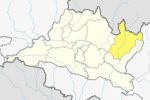Kalinchowk Rural Municipality
Kalinchowk Rural Municipality कालिन्चोक गाउँपालिका | |
|---|---|
 Kuri village, an touristic village near to Kalinchowk Bhagwati Temple | |
 | |
| Country | |
| Province | Bagmati |
| District | Dolakha |
| Wards | 9 |
| Established | 10 March 2017 |
| Government | |
| • Type | Local Government |
| • Chairperson | Mr. Arjun Prashad Shiwakoti (Nepali Congress) |
| • Vice-Chairperson | Mr. Kul Bahadur Budathoki |
| Area | |
• Total | 132.49 km2 (51.15 sq mi) |
| Population (2011) | |
• Total | 22,954 |
| • Density | 170/km2 (450/sq mi) |
| Time zone | UTC+5:45 (Nepal Standard Time) |
| Postal Code | 45500 |
| Area code | +977 |
| Website | kalinchowkmun |
Kalinchowk is a Rural municipality located within the Dolakha district of the Bagmati province of Nepal. The municipality spans 132.49 square kilometres (51.15 sq mi) of area, with a total population of 22,954 according to a 2011 Nepal census.[1][2]
On March 10, 2017, the Government of Nepal restructured the local level bodies into 753 new local level structures.[3][4] The previous Kalinchowk, Babare, Lamidanda, Lapilang, Sunakhani, and Sundrawati VDCs were merged to form Kalinchowk Rural Municipality. Kalinchowk is divided into 9 wards, with Sunakhani declared the administrative center of the rural municipality.
Kalinchowk is a hill station and a tourist hotspot. It is located at 3842 meters of altitude and about 150km northeast from national capital Kathmandu. The place is best known for trekking and skiing.[5] During the December, January and February (mainly Paush and Magh in Nepali months) snowfalls in Kalinchowk.[6]
Demographics
At the time of the 2011 Nepal census, Kalinchowk Rural Municipality had a population of 22,954. Of these, 60.2% spoke Nepali, 34.0% Thangmi, 3.9% Tamang, 1.0% Newar, 0.5% Sherpa, 0.1% Magar, 0.1% Maithili, 0.1% Majhi and 0.1% other languages as their first language.[7]
In terms of ethnicity/caste, 36.7% were Thami, 35.8% Chhetri, 13.2% Hill Brahmin, 4.0% Tamang, 3.0% Newar, 1.9% Damai/Dholi, 1.9% Kami, 1.2% Sarki, 0.6% Majhi, 0.5% Sherpa, 0.3% Magar, 0.3% Thakuri, 0.2% Gharti/Bhujel, 0.1% Badi, 0.1% Terai Brahmin, 0.1% Sunuwar and 0.3% others.[8]
In terms of religion, 69.7% were Hindu, 24.0% Prakriti, 4.5% Buddhist, 1.6% Christian and 0.1% others.[9]
In terms of literacy, 62.6% could read and write, 2.7% could only read and 34.3% could neither read nor write.[10]
Kalinchowk VDC
Kalinchowk is now a neighborhood (village) within Kalinchowk Rural Municipality. It was a separate village development committee (VDC) from 1990 to 2017. Kalinchowk village had 38.19 square kilometres (14.75 sq mi) of area and population according to 2011 had 2806 with 458 individual households. This whole village is now a ward (ward no. 1) of Kalinchowk RM.[11]
Ward division
Kalinchowk RM divided into 9 wards as below:
| Village | Ward no. | area (KM2) | population (2011) |
|---|---|---|---|
| Kalinchowk | 1 | 38.19 | 2,806 |
| Babare | 2 | 16.67 | 3,533 |
| Lamidanda | 3 | 5.82 | 1,888 |
| 4 | 7.93 | 2,344 | |
| Lapilang | 5 | 8.96 | 2,248 |
| 6 | 24.36 | 2,694 | |
| Sunakhani | 7 | 9.93 | 2,369 |
| 8 | 8.23 | 2,306 | |
| Sundrawati | 9 | 12.4 | 2,766 |
| Kalinchowk RM | 9 | 132.49 | 22,954 |
Photo gallery
- Kalinchowk landscape
- Kalinchowk view
- Kalinchowk in 2061 BS (2004-2005)
- Kalinchowk Bhagwati Temple
- Bell at Kalinchowk Bhagwati Temple
- Kalinchowk Bhagawati temple2079 BS (2022-2023)
- Bell and Himalaya's view from Kalinchowk Bhagawati temple
- Himalaya view from Kalinchowk Bhagawati temple.
See also
References
- ^ "District Corrected Last for RAJAPATRA" (PDF). www.mofald.gov.np. Retrieved 17 July 2018.
- ^ "स्थानीय तहहरुको विवरण" [Details of the local level bodies]. www.mofald.gov.np/en (in Nepali). Ministry of Federal Affairs and Local Development. Retrieved 17 July 2018.
- ^ "New local level structure comes into effect from today". www.thehimalayantimes.com. The Himalayan Times. 10 March 2017. Retrieved 17 July 2018.
- ^ "New local level units come into existence". www.kathmandupost.ekantipur.com. 11 March 2017. Retrieved 18 July 2018.
- ^ "Kalinchowk Darshan". Retrieved 2 December 2020.
- ^ "Kalinchowk tour". Retrieved 2 December 2020.
- ^ NepalMap Language [1]
- ^ NepalMap Caste [2]
- ^ NepalMap Religion [3]
- ^ NepalMap Literacy [4]
- ^ "Nepal Census 2001", Nepal's Village Development Committees, Digital Himalaya, archived from the original on 12 October 2008, retrieved 15 November 2009
External links









